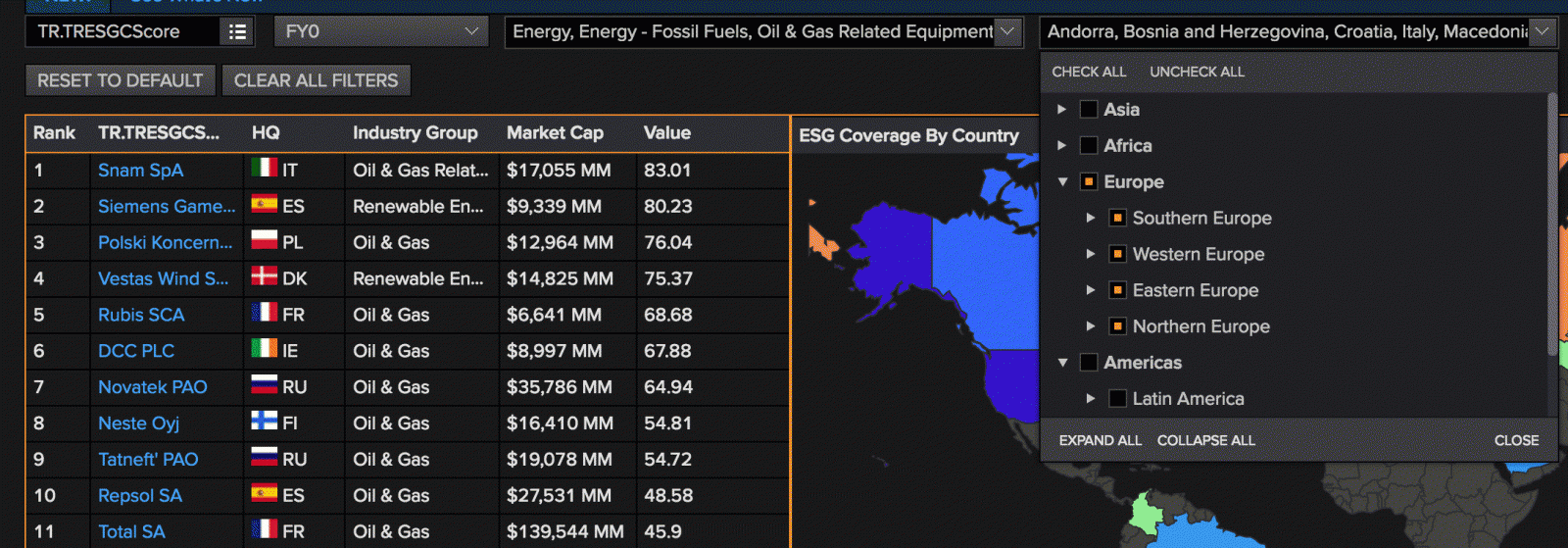The Beginning of the Beginning
This is where we are now. Based on a sample of 7,000 publicly traded companies in Thomson Reuters' ESG data, only around one-half of all large and mid-cap companies fully report what is material about their ESG performance. Some of this data is verified by an external auditor. Some fraction is also delivered in a format so that companies can be compared with each other. Ingesting this dizzying array of ESG sources is an equally dizzying array of ESG data providers or “raters”, which ingeniously bake up full sector reports on ESG performance which allow for comparison of one company with another.
Ranking of large-cap European equities in fossil fuel energy sector

Source: Thomson Reuters Eikon.
The output compensates for varying versions of the truth at the raw data input level, and results vary accordingly at the rating level. The “facts” as determined can vary widely, depending on whether a company’s reported number is taken as is, or is either adjusted to improve its accuracy according to a proprietary estimating methodology, or estimated wholesale, if a company is not reporting at all. After arriving at a set of facts, an ESG rater then generally proceeds to normalise the facts so that all companies can be compared on an “apples to apples” basis. The end result is varying ESG ratings for the same company from different raters. Similar to the facts themselves, the ratings portray different versions of reality on ESG performance.
Finally, enter the consumer of the ratings data, be it an investor, company, policymaker or consumer. How to make sense of this? The answer is that the data do have significant utility for screening negatives from portfolios (e.g. carbon, tobacco, bombs), and perhaps beginning a discussion with a company about its longer-term strategy on how its ESG performance supports risk management, productivity and top-line growth.
Where current tools fall short is when we ask bigger, increasingly pressing questions. How do these companies actually contribute to the sustainable development of the planet? What is their impact? How can we achieve global policy goals like the Sustainable Development Goals (SDGs) with so little uniformity on how to measure leadership in corporate ESG performance?
The End of the Beginning
Where we are headed next will be about reconciling divergent realities in terms of both the facts and the ratings. Technology will steadily improve our capabilities at monitoring and measuring performance using satellites and matrixed data collection devices (Internets of Things). Once facts become more knowable for both transparent and non-transparent firms, then ratings on performance will begin to align. Additionally, coverage of mid and smaller-cap entities will increase, as the cost barriers to data access are reduced. We will begin to be able to meaningfully compare large numbers of companies of different sizes in a sector to each other.
More importantly, new models will emerge for rating a firm’s strategy and performance in leveraging ESG factors for competitive differentiation. As sustainability and its growing collection of technical innovations becomes more and more cost-effective across global business models, ESG ratings will shift in their focus from being about risk avoidance to capturing opportunity. Consumers of the data will want to know where a business model is beginning to capture a new, lower-cost, more sustainable innovation, and therefore delivering better top and bottom-line performance to its owner. Direction of travel, either towards higher or lower states of ESG maturity, will be crucial for diverse investment use-cases, from alpha-capture to carbon-divestment. High ESG ratings will connote lower risk, but more importantly, improved growth and productivity in a firm. ESG will have begun the process of losing its distinction from traditional financial reporting.
The Beginning of the End
At this point, ESG ratings begin to become quite useful for a broad range of investment and non-investment cases. What was a system which at best allowed an observer to compare companies against each other on curve, has morphed into a system which allows a policymaker or a consumer to assess actual performance of a firm versus scientific or policy goals, like the SDGs. In other words, Exxon achieving an A rating (which it does in many ESG ratings tools now), will not only connote that it performs well compared to its oil major comrades, but in addition, a consumer of the data will be able to determine if it performs well against scientific guidance on climate designed to allow for long-term health and value creation across our global economy.
Additionally, clear causal correlations will begin to emerge on how previously distinct strands of ESG data and analysis relate to or reinforce performance in each other. Diversity will have increasingly demonstrable causality for governance which causes a resulting premium in performance in the cost structure and growth potential of carbon-intensive businesses. This, in turn, causes an improvement in local and regional human and ecosystem health, which then improves educational performance and drives economic and cultural output. Measuring and managing the corporate ingredients for a society which can “flourish” will become increasingly possible for stakeholders of all types.
The End of ESG
At the end not only has ESG become a part of Financial Reporting, but also narrowly defined financial performance. ESG data quality will be a non-issue with cost barriers to transparency reduced to near zero and information processing speeds at quantum rates. How and what a company reports will be about how it contributes to the sustainable economic development of its stakeholders, including shareholders and the planet.
And with material, accurate and correlated data abundant, a holistic strategy will be crucial. CEO Larry Fink of Blackrock, the largest investment firm in the world with over US$6trn in assets under management, said in his 2018 letter to the marketplace that “your company’s strategy must articulate a path to achieve financial performance. To sustain that performance, however, you must also understand the societal impact of your business as well as the ways that broad, structural trends—from slow wage growth to rising automation to climate change—affect your potential for growth”. The sooner a company can authentically do this, the greater will be its opportunity to prosper in a world with 9bn citizens sharing a finite set of resources.
Conclusion
In a not too distant future, performance will expand in new ways both beyond the firm and within the firm. As they do now, small groups of enormously powerful individuals will make decisions which affect the lives of countless millions of observers. Those millions of observers will now be observing. Accountability for individual leaders, and their “individual ratings”, will become as important as firm-level performance. Similarly, the network of stakeholders outside a firm will have accountability. Key investors, policymakers, clients, community leaders and even trusted colleagues and influencers will be knowable, not just in their performance record, but also their tendency to drive performance in entities they touch.
ESG will become a part of a larger whole, where progress on sustainable development will be transparent and owned by all who have the ability to impact it, likely accelerating a new era of thorny transparency-related problem-sets to replace ESG.
The views and opinions expressed in this article are those of the authors and do not necessarily reflect the views of The Economist Intelligence Unit Limited (EIU) or any other member of The Economist Group. The Economist Group (including the EIU) cannot accept any responsibility or liability for reliance by any person on this article or any of the information, opinions or conclusions set out in the article.




